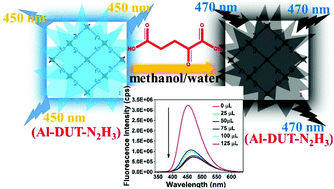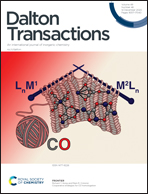Rational design of a functionalized aluminum metal–organic framework as a turn-off fluorescence sensor for α-ketoglutaric acid†
Abstract
A 3D metal–organic framework (MOF) called Al-DUT-5-N2H3 (1) (DUT: Dresden University of Technology) was prepared hydrothermally using Al(III) salt and a hydrazinyl functionalized linker called 2-hydrazinyl-[1,1′-biphenyl]-4,4′-dicarboxylic acid (BPDC-N2H3). Material 1 was successfully characterized by X-ray powder diffraction (XRPD), FT-IR spectroscopy, N2 sorption (BET) experiment, thermogravimetric analysis (TGA), EDX and FE-SEM analyses. The activated form of material 1 (called 1′) was achieved by a direct heating process. Material 1′ was successfully employed for the solution-phase fluorescence detection of α-ketoglutaric acid (α-KG). It showed high detection performance even when there were other competitive analytes present in the mixture. Material 1′ is the first MOF-based fluorescent turn-off sensor for the detection of α-KG. The response time for α-KG is exceptionally low (60 s) as compared to any other reported α-KG sensor. The limit of detection (LOD) was found to be 0.61 μM, which is far better as compared to any other reported sensor for α-KG to date. The mechanism for α-KG sensing was thoroughly investigated and proposed to be PET (photoinduced electron transfer) process by TD-DFT (time-dependent DFT) calculations.



 Please wait while we load your content...
Please wait while we load your content...